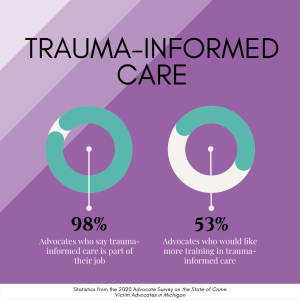New video resource detailing trauma-informed practices
Apryl E. Pooley, PhD – Director of Training and Technical Assistance at the Michigan Victim Advocacy Network

More than ever before, crime victim services organizations are aware of the impact their policies, procedures, and physical environments have on the well-being of both clients and staff. While well-intentioned, operations may not always be conducted in a trauma-informed way because of several common misconceptions about trauma-informed care. This can interfere with trauma survivors’ healing and with the ability of staff to provide consistent, quality services. Ensuring all advocates understand the principles of trauma-informed care—and have skills to translate these principles into practice—is vital to any crime victim services organization.
According to the 2020 MiVAN Advocate Survey, 98% of advocates identified that using trauma-informed care was necessary to do their job. The survey results also showed many advocates still lack confidence in this area. Becoming a Trauma-Informed Advocate follows an advocate who is helping a client prepare to deliver their victim impact statement. During the advocate’s journey of unlearning, the following misconceptions about applying trauma-informed care — in individual practice and at an organizational level — are addressed:
#1 Trauma-informed care isn’t just up to advocates
Trauma-informed care happens at a program, organization, or system level—not at the individual level. Trauma-informed practice asks the organization to consider changing policies, procedures, and environments to guide its staff to create safe space where trauma survivors can receive services. Even organizations that do not provide victim services can be trauma informed. Being trauma informed does not just include the direct care provided to clients, it also asks that all people at all levels of an organization—from front desk staff to maintenance workers—at least have a basic understanding of trauma. Trauma-informed care ensures the effects of trauma on staff are addressed as well. At its core, being trauma-informed means providing services in a way that is accessible to those who have experienced any kind of trauma.
In order to provide consistent trauma-informed services to crime victims, it is crucial that advocates first understand what we actually mean when we use the term trauma-informed. This brief animated video will provide a foundational overview, address common misconceptions, and introduce SAMHSA’s 6 key principles of a trauma-informed approach. A resource library for more in-depth learning is included.
#2 Trauma-specific service is different from trauma-informed care
Helping someone deal with trauma does not always equate to providing trauma-informed care. Being trauma-informed has to do with the way you provide services and not just what specific services you’re providing. Being trauma-informed means operating all aspects of your organization in line with the SAMHSA principles.
#3 An individual’s backstory is not essential to providing trauma-informed care
It can be challenging to know how to help someone who is not able to tell you exactly what is going on with them or remember all the details of their experiences, but you do not need to know another person’s trauma history to be able to provide trauma-informed services to them. Even if you are not specifically treating trauma or you do not even know if your client has experienced trauma, you can take some universal precautions to make sure whatever services you are providing are accessible to clients. You can implement this approach just under the assumption that it is more likely than not that the people you will be interacting with have experienced trauma, and this approach is necessary for them to be able to access your services. And for those who have not experienced trauma, this is still a great approach that will have benefits for everyone.
This video, along with the resources below, provides a foundational overview of what it means to be trauma-informed, with skills that advocates can use to translate the key trauma-informed principles into strengths-based advocacy practice. Trauma-informed advocates are one essential part of an organization-wide approach to realizing the widespread impact of trauma and understanding potential paths for healing.
Additional Trauma-Informed Care Resources
- SAMHSA’s Concept of Trauma and Guidance for a Trauma-Informed Approach – This manual introduces a concept of trauma and offers a framework for becoming a trauma-informed organization, system, or service sector. The manual provides a definition of trauma and a trauma-informed approach, and offers 6 key principles and 10 implementation domains.
- SAMHSA’s Six Principles of Trauma-Informed Care – This infographic from MiVAN reviews SAMHSA’s six principles of trauma-informed care, including a brief description and actionable steps advocates can take to include trauma-informed care in their practice.
- Fortalecer Nuestras Practica | Strengthening Our Practice – This guide from NNEDV describes ten attributes or skills that are essential to dual advocates working with sexual violence survivors. It offers activities, exercises, and questions to help you practice skills and explore new areas of your advocacy practice. Available in Spanish and English.
- 7 tips for providing trauma-informed care to Latin@ survivors of DV – This poster from Esperanza United overviews seven tips for providing trauma-informed care to Latin@ Survivors of domestic violence, including understanding systemic and historical trauma, using strengths-based practices, and more.
- How to Implement Trauma-informed Care to Build Resilience to Childhood Trauma – This brief from Child Trends summarizes current research and promising practices for implementing trauma-informed care to support the well-being of children exposed to trauma and help them reach their full potential. The brief begins with an overview of the nature, prevalence, and impact of childhood trauma, followed by a discussion of related risk factors associated with poor child outcomes and protective factors that support resilience.
- Re-Traumatization Chart – This infographic from Pace Connection illustrates system and relationship dynamics that are often experienced as being re-traumatizing.
- Building Cultures of Care: A Guide for Sexual Assault Services Programs – This guide from NSVRC provides information to support sexual assault services programs in strengthening their organizational and individual responses to survivors of sexual violence through the use of a trauma-informed approach. It provides an overview of the core principles of trauma-informed care and guiding points and questions to help organizations build cultures grounded in the philosophy of trauma-informed service delivery.
- Trauma Informed Principles through a Culturally Specific Lens – This document was developed by Esperanza United. It is a resource for defining the principles of trauma-informed work through a Latinx culturally specific lens, but is also applicable more broadly.
- MiVAN’s Trauma Informed Services Resource Library – To find even more resources and information about trauma-informed care, take a look at MiVAN’s trauma-informed services resource library.

